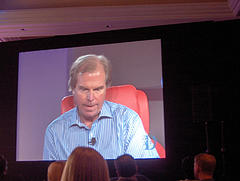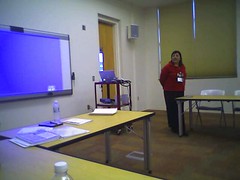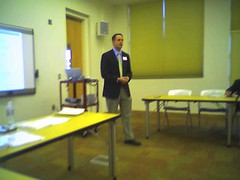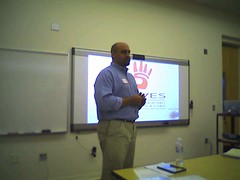I’m not a huge Blogvangelist. It’s one of many tools out there, all of which I recognize as being in flux. It didn’t exist as an important part of my world two years ago, and perhaps will fade out in the next two years. I’ve been around long enough to accept that fads come and go, and that it takes nothing from their value to recognize this.
But blogging makes such a great and simple lens through which to witness and interact with the new information environment. In the old environment, you typed your knowledge and ideas on paper, or scratched it with a pencil. Then you carried it to its destination. You read books that you walked or road to obtain and that others walked or road to deliver. You drove to the theater, bought CDs (Albums in my world) at the store you walked to, consumed information that somebody handed to you.
It was a foot and mouth information environment, and our information economy road on wheels.
Our children have sprouted wings, and most of us don’t even see them. Mark Ahlness blogged a story yesterday about his classroom, where school technicians were working on the LAN, resulting in the students’ network folders being inaccessible. They had access to the Internet, though. One Student needed to print something, but did not have access from her computer to the printer in the corner of the room. Mark continues…
She was typing in Word – wanted to print, but could not – and could not save to her network folder. But she had Internet access. There was only one computer in the room that had access to our printer at that time. She turned to me and said, “Couldn’t I just copy and paste this to my blog – like not ask for it to be published or anything? Just save it there…. and then I could go to that other computer that can print, log on to my blog, open that saved article, copy and paste my writing from my blog article into Word – and then print? Like, would that work?”
“Like, my goodness,” Mark says. He has butterflies in his classroom (3rd grader butterflies), and Mark sees the wings, and he rests in awe that these kids are learning, practically by themselves, that they have wings.
It’s going to happen. But will it happen with our guidance, or without? Will it happen to a generation of children, or to a select few and privileged? Will our future be one that matches the times, or one that frustratingly looks longingly back to better times, because those are the times we prepared our children for?
Got to get thing together. Flying to Utah today.

 I woke this morning with rather more solid ground under my feet than usual, because I woke up thinking about the past. I’m a peculiar sort of edgeek, because, unlike so many ed tech’ers who came out of business education and math, I use to be a history teacher. But it makes sense to me. I always taught history from the perspective of technologies — that when we invented the bow and arrow, it changed our cultures in these ways. When we invented agriculture, it changed how we lived. When I saw that first Radio Shack (
I woke this morning with rather more solid ground under my feet than usual, because I woke up thinking about the past. I’m a peculiar sort of edgeek, because, unlike so many ed tech’ers who came out of business education and math, I use to be a history teacher. But it makes sense to me. I always taught history from the perspective of technologies — that when we invented the bow and arrow, it changed our cultures in these ways. When we invented agriculture, it changed how we lived. When I saw that first Radio Shack ( Anyway, this blog has gotten to long, and it’s time for me to get to work. But all of this has led to something important. At the AZTEA conference last week, a representative of ISTE announced that Negroponte will be one of the NECC keynote speakers this year. Another of my life’s goals, almost achieved.
Anyway, this blog has gotten to long, and it’s time for me to get to work. But all of this has led to something important. At the AZTEA conference last week, a representative of ISTE announced that Negroponte will be one of the NECC keynote speakers this year. Another of my life’s goals, almost achieved.
 Several months ago, in an interview at the
Several months ago, in an interview at the  The article featured the work of New Zealand researcher, James Flynn, and what’s been called the
The article featured the work of New Zealand researcher, James Flynn, and what’s been called the 
 Yesterday afternoon, I attended an
Yesterday afternoon, I attended an  I’m sitting in the Friday Institute. More about that later, but we are just beginning a MEGA meetings. More about that later. Dr. Lisa Grable is introducing things, and I just found my way into their wireless network, so I’ll be blogging this in real time. According the Grable, on the day that they opened this center they were the most “wired-up building on the campus.” Only days later, other centers on the campus of North Carolina State University got ideas for enhancing their services, and have since surpassed the Friday Institute.
I’m sitting in the Friday Institute. More about that later, but we are just beginning a MEGA meetings. More about that later. Dr. Lisa Grable is introducing things, and I just found my way into their wireless network, so I’ll be blogging this in real time. According the Grable, on the day that they opened this center they were the most “wired-up building on the campus.” Only days later, other centers on the campus of North Carolina State University got ideas for enhancing their services, and have since surpassed the Friday Institute. Matt Friedrick is going to start the show, entitled “Collaboration in a Flat World”. He is project manager for North Carolina in the World. Kids will be selling to the world and buying from the world. 1,100 companies in NC are doing business internationally.
Matt Friedrick is going to start the show, entitled “Collaboration in a Flat World”. He is project manager for North Carolina in the World. Kids will be selling to the world and buying from the world. 1,100 companies in NC are doing business internationally. Next is Dr. Len Annetta is a science educator educator. He’s talking about HIFIVES – highly interactive fun internet virtual environments in science. As Len started to approach folks with strategies for using technology in science instruction, he suggested that they use video games. People didn’t like the idea. But then when he suggested HIFIVES, they bought in. They like acronyms more than they like video games.
Next is Dr. Len Annetta is a science educator educator. He’s talking about HIFIVES – highly interactive fun internet virtual environments in science. As Len started to approach folks with strategies for using technology in science instruction, he suggested that they use video games. People didn’t like the idea. But then when he suggested HIFIVES, they bought in. They like acronyms more than they like video games.